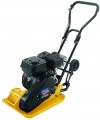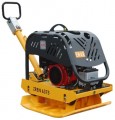Plate compactor
The format of work provided for in the design of the vibrating plate (see "Type").
- Straightforward. Vibratory plates, providing for movement only forward. For a second pass through the same area, the vibrating plate has to be deployed, or run in a circle; both can be a problem in cramped conditions. At the same time, such conditions are not very common in fact, and the design of such units is quite simple, which has a positive effect on the cost.
-
Reversible. Vibrating plates capable of switching the direction of movement and moving both forward and backward. This feature is indispensable when working in narrow areas where there is no space for a turn; on the other hand, it significantly affects the cost of the unit, and therefore it is rarely provided, mainly in professional-level models.
Impact force
The force of each impact provided by the vibrating plate during operation. The intensity of the impact directly depends on this indicator, and, consequently, the density and thickness of the material that the vibrating plate can effectively compact. At the same time, in some cases (for example, when working with paving slabs), a high impact force may be undesirable. Recommendations on the optimal value of this indicator for different cases can be found in special sources.
Vibration frequency
The frequency of movements made by the sole of the tool in normal operation. For different materials, the optimal vibration frequency may also be different; specific recommendations can be found in special sources. It should be noted that classical vibrating plates (see "Type") have a rather high frequency of operation — from 3700 beats / min and above, but in vibrating rammers this figure is much lower and rarely exceeds 700 beats / min; such differences are due to differences in the way they work.
Sole length
The length of the sole — the working surface of the sole. The sole area depends on the length and width (see below) — that is, the space captured by the vibrating plate without moving from its place. Larger soles are comfortable for large volumes of work in wide spaces, while more compact ones perform better in tight spaces and apply more pressure (all other things being equal).
Sole width
The width of the working surface of the vibrating plate. The area of the sole depends on the length and width, respectively, its suitability for processing large spaces. Specifically, the width determines, on the one hand, the size of the strip captured in one pass, on the other hand, the passability of the unit. So, for open spaces, wide soles will be convenient, they will allow you to cope with the processing in fewer passes; but when working in narrow places, the width should be small, otherwise the vibrating plate may simply not fit in the right place.
Compaction depth
The depth of compaction provided by the vibrating plate, in other words, the maximum thickness of the material layer that the unit is capable of compacting with high quality. This parameter is directly related to weight (see below), but models of similar weight may still differ in compaction depth — especially if they are of different types (see above).
Anyway, a large compaction depth is convenient when working with layers of material of great thickness, but it significantly affects the weight, fuel consumption, and most importantly, the price of the vibrating plate. In addition, in many cases it is possible to compact the material in layers, in several passes. Given all this, it is worth specifically looking for a model with a large compaction depth only if the ability to cope with a thick layer of material in one run is critical.
Speed
The speed of the vibrating plate in normal operation. This parameter, along with the size of the sole, determines the performance of the unit. High speed allows you to quickly cope with a vast amount of work, however, it requires the appropriate engine power, which affects the "gluttony" and the price of the vibrating plate.
Motor type
The type of motor used in the vibratory plate.
—
Petrol. Gasoline internal combustion engines are the most popular option among modern plate compactors of all types (see above). This is due to the fact that such internal combustion engines do not depend on power sources (unlike electric ones), while they are relatively inexpensive and easy to maintain (unlike diesel engines), and the power generated by them can be quite high — sufficient even for the most heavy professional models. However gasoline engines (like all internal combustion engines) are distinguished by a high level of noise and produce exhaust gases; however, given the specifics of the application, these shortcomings can hardly be called critical.
—
Diesel. Diesel internal combustion engines compare favorably with gasoline ones in higher power at lower fuel costs. However they are heavier, but in this case this can hardly be attributed to disadvantages — a lot of weight is usually desirable for a vibrating plate. But what are the unequivocal disadvantages is the high cost of the motors themselves, the complexity of their operation and poor suitability for operation at sub-zero temperatures. As a result, diesel engines are predominantly installed in heavy professional vibratory plates, for which high power is a decisive factor.
—
Electric. Electric motors have a number of advantages i
...n terms of ease of use: they are simple and inexpensive (both by themselves and in operation), create noticeably less noise than internal combustion engines, and do not produce exhaust gases. At the same time, for the operation of a vibrating plate with such a motor, an external power source is required, and freedom of movement is limited by the length of the mains cable (it can be increased with extension cords, but the work is still not very convenient). Thus, electric motors are rarely used, mainly among vibrorammers (see "Type").Motor type
Model of the engine installed in the vibrating plate. With this data, you can refine the detailed characteristics of the engine, which is important for some specific tasks. In addition, model information can be useful when repairing or searching for spare parts.

